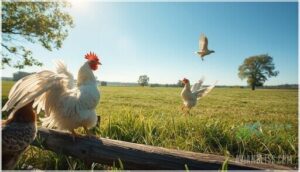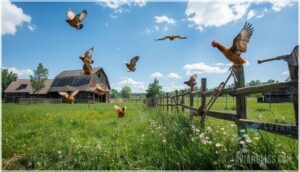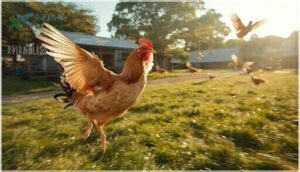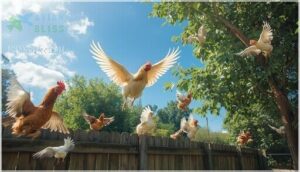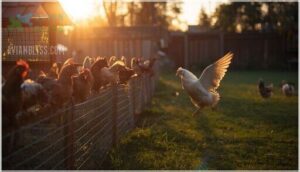This site is supported by our readers. We may earn a commission, at no cost to you, if you purchase through links.
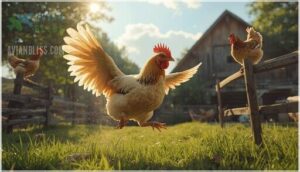
Whether you’re wrangling escape artists or simply curious about what makes a chicken take flight, understanding their aerial abilities can transform the way you manage your flock and keep your birds safe.
Table Of Contents
Key Takeaways
- Chickens can fly, but their abilities vary dramatically by breed—light breeds like Leghorns and Bantams can clear six-foot fences and reach heights of 10-15 feet, while heavy breeds like Orpingtons and Brahmas barely lift off the ground due to their body mass and wing structure.
- Flight in chickens is driven by survival instincts (predator avoidance, reaching high roosts), curiosity, and foraging motivation, with most flights lasting only 10-13 seconds and covering 40-50 feet at speeds up to 10 mph.
- Wing trimming is the most practical method to prevent escape attempts—cutting primary flight feathers on one wing disrupts balance and limits altitude to 1-2 feet without causing pain, though it requires monitoring after molting when feathers regrow.
- Secure containment requires six to eight-foot fencing made of hardware cloth or welded wire, overhead netting to block aerial predators, and wire buried 6-8 inches deep to prevent tunneling, creating a safe environment that respects chickens’ natural behaviors while preventing escapes and predator attacks.
Chicken Flight Basics
Regarding chickens, flight is more than just flapping wings. Their history, body shape, and breed all play a role in how high and far they can go.
Let’s look at the different ways you can keep your flock safe and secure.
History of Chicken Flight
Evolution Origins tell a story of wings clipped by time. If you picture the wild ancestors of chickens—ancient fowl darting through jungle shadows—you’ll see flight adaptations built for survival. Those bursts into the treetops weren’t just for show; they kept jungle fowl alive. But as humans stepped in, domestication effects took center stage. Selective breeding for meat and eggs changed chicken flight capabilities, turning agile flyers into grounded birds. The historical context of chickens is marked by this shift from sky to coop.
Want to feel the change? Here’s how the journey unfolded:
- Wild ancestors soared short distances to escape danger.
- Ancient fowl roosted high above ground.
- Domesticated birds lost flight as priorities shifted.
- Selective breeding favored size and productivity over wings. This loss of flight is closely related to the flight capability issues.
Physical Characteristics of Flying Chickens
You might think chickens are all fluff and bluster, but their ability to fly—however modest—comes down to some clever engineering. It’s all about Aerodynamic Features—chickens are made for short hops, not soaring.
Look at Wing Anatomy: their wings are short and rounded, built for quick bursts. Body Proportion matters too; most chickens carry more weight than their wings can handle for long hauls. Muscle Composition gives them that explosive jump, but not much stamina. Feather Structure, especially those flight feathers, adds a little lift.
Understanding chicken flight patterns is vital for their care. Here’s what sets them apart:
| Feature | Purpose | Flight Effect |
|---|---|---|
| Wing Shape | Quick Lift | Short Bursts |
| Body Proportion | Weight Balance | Limits Range |
| Muscle Composition | Power Launch | Brief Flight |
| Feather Structure | Airflow Control | Adds Lift |
| Bone Structure | Flexibility | Aids Movement |
Breed Variations in Flight Ability
Now that you know what makes a chicken’s body tick, let’s talk about how breed genetics and chicken breed characteristics shape their flight patterns. Some breeds act like daredevils, while others barely leave the ground. Bantams, with their compact wing structure and strong flight muscles, zip over fences with ease. Mediterranean breeds—think Leghorns—have feather types built for quick escapes. Heavy breeds like Orpingtons and Brahmas? They’re grounded, thanks to their size. Silkies, with their fluffy plumage, don’t even try. Your flock’s chicken flight ability depends on these quirks.
Want specifics? Here’s what sets breeds apart:
- Bantam flyers
- Mediterranean escape artists
- Heavy, grounded breeds
- Heritage survivors
- Fluffy, flightless Silkies
Can Chickens Fly
So, can chickens fly? The answer is yes, but don’t expect a barnyard version of an eagle. Chicken flight is all about short bursts—think of it as a determined leap rather than a graceful glide. Their flight abilities hinge on chicken physiology and wing structure; heavy breeds lumber along with a few feet of lift, while bantams and light breeds can clear fences and soar up to 15 feet high.
Thanks to their unique flight mechanics and aerodynamic lift, chickens fly just enough to escape trouble or reach a high perch. It’s not about distance, but about survival and curiosity. Next time you see a chicken take off, you’re witnessing a quirky blend of ancient instincts and modern chicken flight capabilities in action.
Why Chickens Fly
Chickens have plenty of reasons to take flight, and it’s not always what you’d expect. From curiosity to survival, their instincts kick in when the moment calls for it.
Let’s look at what drives them to spread their wings.
Curiosity and Exploration
Ever watched a chicken launch itself over a fence just to see what’s on the other side? That’s pure curiosity at work—a drive that rivals any explorer’s urge for discovery. When boredom strikes or something catches their eye, their chicken wing structure and sharp spatial cognition kick in. You’ll spot them testing boundaries, investigating flowerbeds, or chasing shiny objects, all thanks to their knack for exploratory learning and foraging behavior.
Environmental Enrichment—like new plants or UV light—amps up this curiosity, making their adventures even bolder. Contrafreeloading means they’ll work for food, just for the thrill of the hunt. Their flight isn’t just about distance; it’s about the joy of exploring.
- Seeking hidden treats and novel objects
- Roosting in unexpected, high places
- Exploring new spaces for sensory stimulation
Fear and Predator Avoidance
Survival instinct is the backbone of chicken flight. When predators lurk, Fear Responses kick in—some birds freeze, others explode into motion. Lighter breeds excel at Predator Avoidance, launching vertical escapes or darting for cover. Flight Mechanisms help them reach high roosts, but Escape Strategies vary by breed and age. Threat Recognition is surprisingly sharp; they react to looming shadows or sudden movement.
Here’s how breeds respond to predators:
| Breed | Response Type | Escape Tactic |
|---|---|---|
| Leghorn | Active | Rapid flight |
| Wyandotte | Passive | Freezing |
| Bantam | Active | High perching |
| Araucana | Mixed | Darting/fleeing |
| Silkie | Passive | Hiding |
Foraging and Food Motivation
Curiosity is the driving force behind Forage Behavior in backyard chickens. When food motivation kicks in, you’ll see hens leap fences or flutter up to garden beds, all in pursuit of Natural Foraging and Dietary Enrichment. Their foraging strategies aren’t just random pecks—they’re calculated moves shaped by chicken behavior and breed. Your flock’s safety depends on understanding these patterns, especially if you want to keep prized veggies out of reach.
For instance, you’ll notice them:
- Spotting and chasing after insects
- Exploring new corners for hidden seeds
- Hopping barriers for fresh greens
- Testing boundaries for tastier finds
Smart chicken care means channeling these instincts for a healthier, happier flock.
Social Interaction and Communication
Think of your chicken flock as a bustling neighborhood—sometimes flight is all about keeping the peace. You’ll see backyard chickens take to the air to join friends, dodge squabbles, or reinforce pecking order.
Flock Dynamics and Vocal Cues drive chicken social interaction, while Chicken Empathy and Social Learning shape group behavior. It’s communication in motion—literally.
Chicken Flight Capabilities
So, how far and high can chickens really go when they take off? Their flight isn’t quite like a sparrow’s, but there’s more to it than most folks think.
Let’s break down what you can expect from your flock’s flying abilities.
Distance and Speed of Flight
Regarding chicken flight distance, you’re dealing with short bursts, not marathon journeys. Most chickens max out at 40–50 feet, zipping along at speeds up to 10 mph. Their flight patterns depend on breed, muscle power, and aerodynamic forces.
Here’s how the numbers stack up:
- Longest flight: 301.5 feet
- Bantam range: nearly 100 feet
- Heavy breeds: 10–15 feet
- Typical: 2–3 seconds airborne
- Fastest: 10 mph
Wing beats and air resistance shape every flight trajectory.
Height and Altitude of Flight
Ever watched a chicken launch itself skyward and wondered how high it’ll go? Their flight patterns aren’t just random flutters—chicken flight capabilities depend on breed, wing structure, and aerodynamic factors. Most backyard birds hit altitude limits of 4–6 feet, but agile breeds like Leghorns and bantams can reach up to 15 feet, especially in escape mode. Vertical flight is their specialty, not long glides. Wing anatomy and flight feathers play a big role, and wing trimming knocks their hops down to just a couple feet.
Here’s the reality:
- Light breeds: 10–15 feet
- Heavy breeds: 2–4 feet
- Wing trimmed: 1–2 feet
Duration of Flight
After you’ve seen how high a chicken can go, you’ll notice their airborne time is short-lived. Most chickens max out at around 13 seconds in the air, covering a flight distance of 300 feet if they’re feeling bold.
Their wing movement and aerodynamic lift just aren’t built for endurance. Flight patterns rely on quick bursts—just enough to escape or reach a roost. So, chicken flight capabilities favor speed over lasting flight range.
Vertical Vs Horizontal Flight
If you’re wondering about chicken flight capabilities, vertical takeoff is their showstopper. Their wing movement packs enough punch for a leap skyward—think 10 feet up if they’re light breeds. But horizontal flight? That’s another story. Air resistance and chicken wing anatomy keep them grounded after 30–40 yards. Their flight patterns favor speed over distance, and abrupt landings prove their aerodynamics are quirky at best.
- Vertical lift: strong, brief, impressive
- Horizontal travel: short, awkward, limited
- Landings: abrupt, clumsy, unpredictable
Breeds That Can Fly
Some chicken breeds are surprisingly good at getting airborne. If you’ve ever watched a bantam or a Mediterranean breed take off, you know what I mean. Let’s take a look at which types really know how to spread their wings.
Light Breeds and Bantams
Light breeds and bantams bring a bit of drama to flock dynamics with their lively flight patterns. You’ll notice Mediterranean flyers like Leghorns and agile bantam breeds launching themselves over fences and up to high roosts—sometimes four to six feet in a single bound.
Their feather structure and small size give them a real edge in chicken flight capability. If you’re looking for breeds that keep you guessing, these chickens are escape artists, blending curiosity, bold roosting behavior, and a knack for aerial exploration.
Strong Flying Breeds
If you’re after chickens that really show off, strong flying breeds bring serious flair to the flock. Their flight patterns aren’t just luck—they’re built for it. Here’s what sets these breeds apart:
- Lean bodies and powerful flight muscles for strong takeoffs.
- Wing structure designed for agility and lift.
- Aerodynamic feathers that slice through the air.
- Larger wingspans relative to body size.
- Keen instincts and sharp awareness for quick maneuvers.
That’s how breed selection shapes chicken flight capabilities.
Examples of Flying Breeds
Escape isn’t just a hobby—it’s an art form for some chicken breeds. Leghorns, for example, have flight patterns that let them clear six-foot fences with ease. Bantams are nimble and bold, soaring into treetops thanks to their lightweight frames and sharp chicken aerodynamics. Heritage breeds like Araucanas and Ancona flaunt impressive flight abilities rooted in fowl genetics and feather structure.
When you choose breed selection wisely, you’re inviting adventure—these flying breeds can outwit standard barriers and reshape what backyard freedom looks like.
Breeds That Can’t Fly
Some chickens just aren’t built for flight, no matter how much they flap. Certain breeds have heavy bodies or unusual feathers that keep them grounded. If you’re wondering which ones won’t be taking off, here’s what you need to know.
Heavy Breeds and Their Limitations
Ever seen a Brahma try to take off? It’s like watching a suitcase sprout wings. Heavy chicken breeds face some serious flight barriers. Their body mass dwarfs their wing structure, making true flight a pipe dream. These breeds, like Orpingtons and Brahmas, are grounded by aerodynamic constraints and breed limitations. Their bulky frames just aren’t built for the sky. Instead, they waddle and hop, sticking close to earth by design.
Here’s why heavy breeds can’t soar:
- Body Mass outweighs lift potential
- Small wing structure limits altitude
- Flight abilities drop with poor aerodynamics
- Energy reserves run out fast
- Breed limitations favor ground-living traits
Breeds With Atypical Plumage
Feather structure can really ground a bird. With certain chicken breeds, you’ll see how plumage types shape flight—or stop it outright.
Silkies, for instance, wear their soft, downy coats more like pajamas than feathers built for liftoff, offering almost no air resistance or lift. Frizzle chickens sport riotous, curled feathers that act like a parachute, dragging them down instead of letting them soar.
Then there’s the Polish: their oversized crests block vision, making takeoff a gamble. These breed characteristics, and other atypical traits, create natural flight restrictions and change chicken behavior around flight.
Examples of Non-Flying Breeds
Looking for a chicken that won’t take flight? Some breeds are grounded by design. Thanks to heavy breed limitations, feather density impact, and ground-dwelling behavior, these birds stay put. Their wing-to-body ratio and breeding for size keep them earthbound.
Here are five classic examples:
- Orpingtons
- Silkies
- Cochins
- Wyandottes
- Australorps
These chicken breeds and flight just don’t mix—earth is where they shine.
Preventing Chicken Flight
If your chickens keep trying to make a break for it, you’ve got options to keep them grounded.
There are a few practical ways to limit their flight and protect your flock. Here’s what you can do to keep those escape artists in check.
Wing Trimming Methods
Think your flock’s plotting a jailbreak? Wing Trimming is your secret weapon for Flight Restriction and solid Flock Management. With the right Trimming Techniques, you keep birds safe—without drama.
Chicken wing trimming is simple: snip the primary flight feathers on one wing, which unbalances their lift. For persistent flyers, chicken wing trimming techniques might include trimming a few secondary feathers too. Always use sharp poultry shears for clean Feather Clipping.
Here’s your quick guide:
- Trim only matured primary feathers.
- Check for regrowth after molting.
- Hold birds gently—never rush.
Wing clipping isn’t cruel; it’s practical. Your flock stays grounded, healthy, and exactly where you want them.
Brailing and Restrictive Techniques
Feeling rebellious about chicken containment? Brailing Methods are your bold answer for Flight Restriction when wing trimming just won’t cut it. By wrapping one wing with a soft cord, you disrupt balance and keep escape artists grounded. Rotate the restraint weekly—think of it as responsible Avian Management.
Gentle handling is key; you’re aiming for Wing Control, not discomfort. For those uneasy about Restraint Techniques, wing trimming remains a reliable way of restricting chicken flight without long-term fuss.
Building Secure Chicken Runs
If brailing feels too restrictive, let’s talk chicken containment with some real backbone—your chicken run. Coop security starts with the right fencing materials: hardware cloth, 6–8 feet tall, stops escape artists and keeps predators out. Run design matters too; a covered chicken run using netting or metal mesh blocks hawks and raccoons from swooping in.
Want escape prevention? Bury wire 6–8 inches deep, or flare it out at the base—foxes won’t tunnel through that. A good chicken fence isn’t just a barrier; it’s peace of mind.
Try these for chicken escape prevention:
- Overlap hardware cloth panels for zero gaps
- Use knotted poultry netting overhead
- Add sand or grass for enrichment
Chicken Flight Development
Regarding chickens learning to fly, there are a few things that shape how and when they take off. Their age, breed, and environment all play a part.
Let’s look at some enclosure options that can help manage their flighty instincts.
Age of Flight Capability
By week five, your chicken chicks start showing off their first flight feathers—a real turning point in Flight Development. You’ll spot clumsy hops and awkward glides as they enter the Fledgling Stage.
Lighter breeds often zip past heavier ones, mastering Juvenile Flight sooner. Wing Maturation brings sensitivity, so handle those blood quills gently.
By ten weeks, myths fade: most chicks can clear brooders, proving their flight capabilities are no joke in early Chick Growth.
Factors Affecting Flight Development
If your chicks are already flapping around, you’re seeing the result of several factors influencing flight attempts. Genetic Factors play a big role—some breeds are born to soar, others just shuffle. Wing Structure and Muscle Growth shape how well they lift off, while Feather Condition can make or break those first flights. Environmental Influences? Huge. Space, light, and freedom to move all boost flight capabilities.
Here’s what matters:
- Strong genetic background
- Healthy feather development
- Balanced nutrition for muscle growth
- Spacious environment for practice
- Proper chicken wing structure and function
Learning to Fly and Practice
Once those flight feathers start coming in, you’ll notice bold little hops and flutters—each one a lesson in learning to fly. Chick Training is all about Flight Practice: repeated flapping strengthens muscle, sharpens coordination, and refines Flight Techniques.
Give your chicks perches or open space, and watch Wing Development take off. Muscle Building happens with every attempt. The right chicken wing structure and environment set the stage for confident flight abilities, turning those clumsy leaps into short, spirited journeys.
Chicken Flight and Safety
Keeping your chickens safe takes more than just hoping for the best. There are real risks out there, from sneaky predators to accidents in the yard.
Here’s what you should know about the different ways to keep your flock protected.
Predators and Threats
Ever wondered what keeps your flock up at night? Predator Behavior is the real wild card in chicken safety and predators. Hawks swoop in from above, raccoons sneak through the shadows, and foxes play the long game.
Threat Analysis isn’t just theory—it’s daily reality. Your birds rely on quick wing work for predator defense, but their limited flight only goes so far.
Flock Security means knowing your enemy and using smart Predator Deterrents to keep chicken predators from turning your coop into a midnight buffet.
Fencing and Enclosures
For chicken fence requirements, think bold—your flock deserves a fortress. Secure coops and smart enclosure designs make all the difference. Six-foot fences stop most escape artists from flying over, and mesh chicken nets keep predators out. Regular checks catch sneaky gaps before trouble starts. Clever placement of roosts adds another layer of flight prevention. Here’s your quick checklist:
- Welded wire or galvanized Fence Materials
- Chicken Nets for overhead protection
- Strategic Enclosure Designs
- Tall Fences for flighty breeds
- Regular chicken coop security inspections
Health Risks and Injuries
Risk is a constant companion for chickens who take to the air. Your flock’s short flights aren’t just playful leaps—they come with real hazards. For instance, awkward landings often result in flight injuries like fractures or sprains, especially to the keel bone. Muscle atrophy can set in after wing damage or feather loss, making future escapes even riskier. There’s also the threat of flystrike risks—open wounds from rough landings or predator attacks invite maggots and infection.
Here’s what you need to watch for:
- Landing injuries: fractures, sprains, and wing damage.
- Muscle atrophy from lost flight feathers and molting.
- Flystrike risks and predator wounds, especially in poorly trimmed wings.
Smart wing trimming and vigilant chicken health checks keep danger at bay.
Managing Flying Chickens
If your chickens keep testing the boundaries, you’ve got a few ways to keep them grounded. Some methods are simple, others take a bit more effort.
Let’s look at what you can do to manage their flighty habits.
Strategies for Containment
Want to foil your chickens’ next great escape? Start with fence design—a six-foot barrier is the benchmark for stubborn fliers. Pair this with netting solutions over runs, and escape attempts drop fast.
Nothing says “stay put” like strategic wing trimming—it’s a flight deterrent that doesn’t hurt when done right.
Add in tough latches, buried wire, and you’ve got serious enclosure security—chicken containment methods that truly keep your flock grounded.
Training and Behavior Modification
Think you have to clip every wing to keep your flock in check? Try a different flight plan—shape chicken behavior with smart Training Methods. Operant Conditioning works wonders: reward grounded birds with treats, and soon escaping won’t cross their minds. Toss in a little Environmental Enrichment—scatter foraging toys, set up varied perches, and those restless wings stay busy right where you want them.
Here’s what matters most:
- Reinforce staying habits with food rewards.
- Use environmental tweaks to deter flying.
- Observe chicken behavior patterns and adjust Flight Conditioning.
Escape attempts drop, and everyone wins.
Breeding for Reduced Flight Capability
Ever wonder why most chickens barely get off the ground these days? It’s not just nature at play—it’s years of clever Selective Breeding. Through focused Breeding Techniques and Genetic Modification, modern flocks pack heavy muscle, especially in the breast, and sport undersized wings. That’s the impact of Flight Genetics and Domestication Effects in action.
Chicken breeds and flight are linked: big, stocky breeds can’t soar while lighter, heritage types still surprise you. These breeding impacts trump old-school tricks like chicken wing binding techniques. Today, chicken breed characteristics are quite literally grounded—by design, not by accident.
Frequently Asked Questions (FAQs)
Can chickens fly high?
If you’re hoping for a barnyard rocket, think again. Chicken flight patterns are limited by altitude limits, wing structure, and air resistance. Most chickens max out around 8 to 10 feet, barely flying over fences.
Are chickens flightless?
Chickens aren’t truly flightless, but their Avian Mechanics and Fowl Physiology set serious Aerodynamic Limits.
Domestic chicken flight abilities hinge on Wing Structure and breed—short hops, not soaring.
Flight Patterns reflect chicken flight facts and practical limitations.
Can chickens fly over fences?
Strong Chicken Agility means many lighter breeds can clear fences, especially with good Wing Structure and short-burst Flight Patterns. Six-foot Fence Height is usually safest.
Escape Methods like flying or jumping depend on breed, motivation, and proper wing trimming.
How do chickens fly?
Think chickens are ground-bound? Think again. Their flight mechanics rely on rapid wing beats and clever use of lift generation from unique wing structure.
Short bursts of aerodynamic force launch chickens skyward—brief, energetic, and surprisingly agile.
How high can chickens fly?
Flight height limits for chickens top out between 8 and 15 feet, depending on wing structure, breed, and motivation.
Vertical takeoff is possible for light breeds; heavier types may not clear typical fence height without help.
Can baby chickens fly?
You’ll spot fluff, hop, and plenty of wild attempts, but true flight isn’t in the cards for baby chicken wings.
Flight development kicks in between weeks five and ten, with fledging success hinging on healthy feather growth and juvenile flight practice.
Which chicken breeds can fly?
Some chicken breeds surprise you with their flight abilities—Leghorns, Anconas, and Sumatras dart higher thanks to slender wing structure and lively fowl genetics.
Bantams outfly larger breeds, making breed selection key regarding chicken behavior and flight.
Do wild chickens fly?
Wild chickens—descendants of Jungle Fowl—rely on quick, powerful bursts of flight.
In their natural habitat, this isn’t about soaring. It’s swift, short hops—maybe 40 feet—escaping predators, reaching high roosts, and showcasing their ancestral flight patterns.
How far can chickens fly?
Picture a gust of wind twisting through open fields—most chickens, with their unique wing structure and aerodynamic limitations, manage only 40–50 feet in flight distance, cruising four to six feet high, especially when flock flight patterns demand a quick escape.
How long can a chicken fly?
Regarding flight duration, most backyard chickens max out at about 10–13 seconds. Their wing structure and aerodynamic limits keep flights short, with the longest chicken flight on record covering just over 300 feet.
Conclusion
It’s funny how the same bird that clucks contentedly in your coop can morph into an escape artist the moment something spooks her. Now you know can chickens fly isn’t just yes or no—it’s about breed, motivation, and opportunity.
Whether you’re trimming wings, raising fences, or simply appreciating their unexpected bursts of freedom, you’re equipped to manage your flock with confidence. Keep them safe, respect their instincts, and remember: even a grounded chicken dreams of sky.
- https://www.discoverwildlife.com/animal-facts/birds/can-chickens-fly
- https://www.facebook.com/groups/692124331951538/posts/1526416508522312/
- https://www.chickencoopcompany.com/a/blog/can-chickens-fly
- https://grubblyfarms.com/blogs/the-flyer/can-chickens-fly
- https://animalbiosciences.uoguelph.ca/~swatland/HTML10234/LABS/LAB10.2.html

